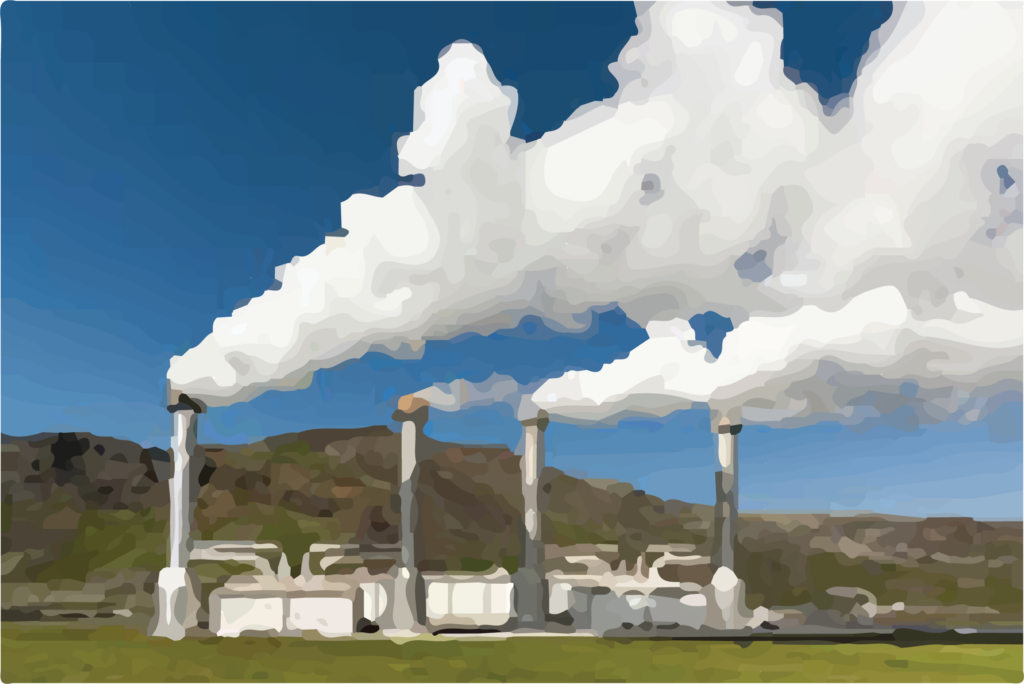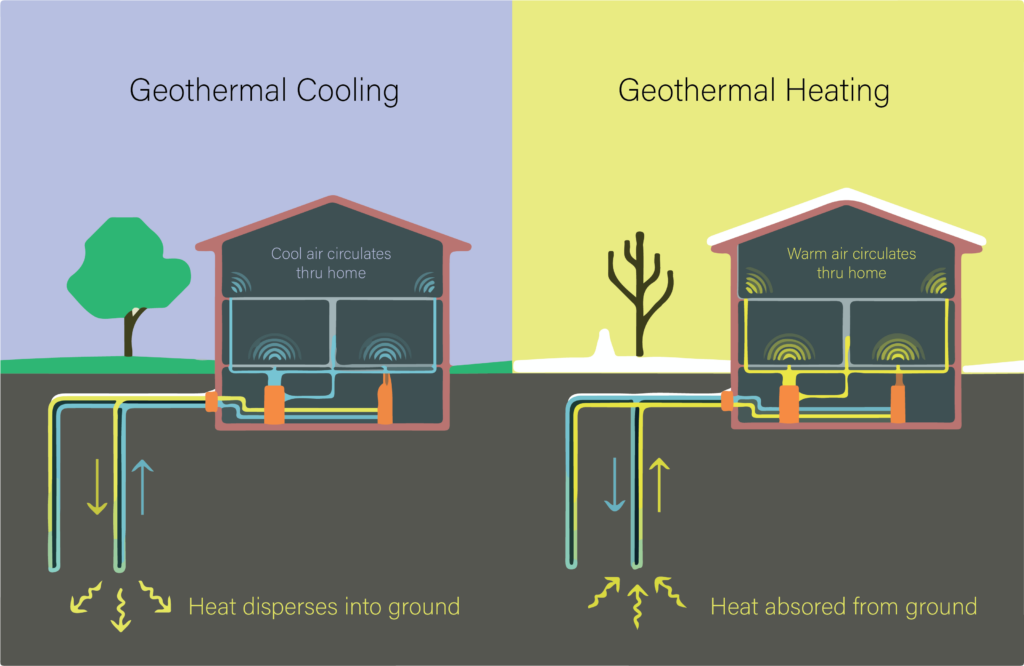
Geothermal energy refers to the heat that comes from the sub-surface of the earth. It is contained in the rocks and fluids beneath the earth’s crust and can be found as far down as the earth’s hot molten rock, magma. This energy can be used for heating buildings, generating electricity, and numerous other applications.
There are many factors to consider when it comes to geothermal energy. Even though it’s a renewable energy source, it is still essential to weigh the pros and cons of geothermal energy in order to better comprehend how it can fit into our larger energy landscape.
Here’s a detailed look into the pros and cons of geothermal energy. Plus, you can get quotes from up to 5 propane dealers in your area today to get the best pricing on propane delivery.
Table of Contents
How geothermal energy works
Geothermal energy systems for residential use harness the earth’s underground temperature to regulate a home’s climate. These systems are composed of three key elements: A ground loop, a heat pump, and a distribution system for the air. The ground loop, essentially the system’s core, involves a network of narrow, high-density polyethylene pipes placed beneath the surface. These pipes circulate water, facilitating the transfer of thermal energy into and out of the home, offering a significant advantage over traditional heating and cooling methods, including standard heat pumps, air conditioners, and systems reliant on fossil fuels.
The operation of the heat pump within a geothermal setup is similar to that of a traditional heat pump: It employs high-pressure refrigerant to shift heat between the interior and exterior of a home. However, unlike conventional units that rely on the external air for heat exchange, geothermal systems use a liquid-filled underground pipe system for this purpose. This method takes advantage of the stable underground temperature, which remains around 50 degrees Fahrenheit, regardless of the weather conditions above ground. This consistency allows geothermal systems to perform more efficiently than air-source heat pumps, which often struggle in extreme temperatures to extract or dissipate heat.

The efficiency of geothermal systems is rooted in the principle that below the Earth’s surface, temperatures remain relatively constant, a fact known to humanity since the days of living in caves. This constant underground temperature makes geothermal systems highly effective and energy-efficient for heating and cooling homes. By leveraging the ground’s steady temperature, these systems can significantly reduce energy consumption and lower utility bills. Furthermore, they represent a more environmentally friendly alternative to traditional heating and cooling methods, reducing reliance on fossil fuels and decreasing greenhouse gas emissions. This makes geothermal energy a smart and sustainable choice for residential climate control.
Pros of geothermal energy
Renewable and sustainable: Geothermal energy is considered renewable because the heat emitted from the Earth’s interior is essentially limitless and will be available for billions of years. Unlike solar and wind energy, geothermal energy is always available, 24/7, regardless of weather conditions. For example, the Geysers in California, the world’s largest geothermal power station, has been producing electricity since the 1960s and still has considerable potential for the future.
Low emissions: Geothermal power plants emit very low amounts of greenhouse gases compared to fossil fuel power plants. This can help reduce air pollution and mitigate climate change. Compared to a coal-fired power plant, a geothermal power plant emits 99% less carbon dioxide and over 99% fewer air pollutants.
Compact footprint: Geothermal power stations require less land compared to most other renewable energy sources. Wind farms, for example, may need up to 20 times more land to produce the same amount of electricity as a geothermal power station.
Consistency: Geothermal power plants can produce electricity consistently, unlike solar and wind, which are intermittent. Iceland, for example, gets about 25% of its electricity and meets the majority of its home heating needs through geothermal energy, thanks to the country’s volcanic geology.
Economic benefits: Areas with geothermal resources can benefit from job creation, increased tax revenue, and decreased energy imports. Countries like Iceland and Kenya have saved significant amounts in energy imports by harnessing local geothermal resources.
Cons of geothermal energy
Location-specific: One of the significant limitations is that it’s location-specific. Only regions near tectonic plate boundaries typically have high enough temperature gradients to produce electricity cost-effectively. While Iceland and parts of the U.S. West Coast have substantial geothermal resources, places like the U.S. East Coast or many mid-latitude regions don’t have the same potential.
Initial costs: High initial capital costs can be a barrier. Drilling operations, particularly in deeper reservoirs, can be expensive. For example, the Hellisheidi Geothermal Plant in Iceland, one of the world’s largest, had significant upfront costs, but operational costs and the environmental footprint are low.
Environmental concerns: While emissions are low, geothermal power plants can contribute to subsurface land degradation, including land subsidence. A prime example of this is the city of Staufen in Germany, which experienced significant ground uplift due to a geothermal drilling project, leading to building damages.
Depletion: If the water or steam is extracted from the ground faster than it’s replenished, the geothermal resource can be depleted. Some geothermal fields in New Zealand, for instance, have seen reduced output over the years due to over-extraction.
Seismic activity: There’s some concern about geothermal drilling causing earthquakes. Enhanced Geothermal Systems (EGS), which involve injecting water at high pressure into hot rock, have been associated with induced seismicity. In Basel, Switzerland, a geothermal project was suspended in late 2006 after it caused several minor earthquakes.
In the end, geothermal energy offers a sustainable, low-emission energy source with a consistent output, but it has limitations related to location, initial costs, and some environmental concerns. Like all energy sources, the pros and cons need to be weighed carefully when considering its implementation.
Get quotes from up to 5 propane dealers in your area today to get the best pricing on propane delivery.
Is geothermal energy expensive?
Although you’ll never be able to get energy for free, geothermal heating and cooling systems — as well as solar panels — come pretty close. Utilizing the constant temperature of the ground, geothermal systems expend less energy than more traditional systems, thus saving you money on energy costs while, at the same time, cutting down on greenhouse gas emissions. When it comes to geothermal energy for your home, a typical geothermal heating and cooling system can cost on average from a low of $17,000, to a mean of about $24,000, and finally, to a high of approximately $32,000.
How long does it take for geothermal to pay for itself?
Geothermal heat pumps and cooling systems are really investments for the long-term. While the initial costs might be on the higher side, geothermal energy systems generally have a long lifespan, taking an extensive amount of time for them to degenerate to the point of significant repair or replacement. Geothermal heat pumps and cooling systems are up to 65% more efficient than traditional HVAC units and take approximately 10 years to eventually pay for itself.
Get quotes from up to 5 propane dealers in your area today to get the best pricing on propane delivery.
